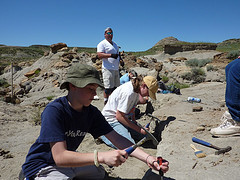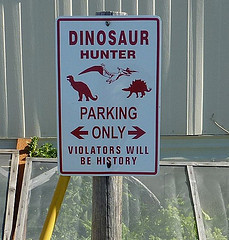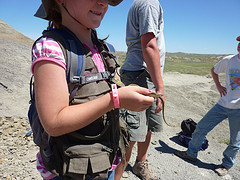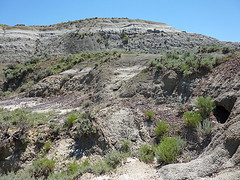Michele Torrey's Blog, page 2
July 9, 2010
Bone Digging at Hell Creek — Part II

Ten-year-old Liam gives fossil-hunting a try.
I'll be honest, I wasn't sure whether I'd like squatting in the dirt all day long under the hot Montana sun, chipping away at dirt or at a rock wall with my dino-hammer. PaleoWorld warned me when I signed up: "This is not a tour." They weren't kidding. If one doesn't like heat, bugs, dirt, thundershowers, squatting, sitting on rocks, or hammering until your arm falls off, then maybe a visit to an air-conditioned dinosaur museum would be a better choice.
Some people didn't tolerate it too well; after five minutes of chip-chip-chipping with the ol' sweat drip-drip-dripping, they'd sit and yak with their neighbor, or check their watch to see if it was lunchtime yet. Not me, man. Turns out, fossil-hunter blood flows through my veins. I was content to dig for eight hours a day, heat or not, fueled by the anticipation of discovery.

Violators have been warned!
At first, the discoveries were modest: croc teeth and croc skin (called scute), dino dung (coprolite), small therapod teeth, mini-vertebrae, fish scales, weathered fossil bone, hadrosaur teeth, tortoise shell, and pieces of triceritops frill. But then came the day when we went to one of Jessica's must-watch microsites.
Now Jessica Martin is PaleoWorld's intrepid, ever-patient paleontologist and field leader. For the past three years, she had been dutifully keeping an eye on this area as it was sloughing off large pieces of rib bone. Three times a year she scouted the area, looking for the source — the dinosaur embedded in a sedimentary layer, eroding off bits of bone as it gradually became exposed and weathered. . . .
So on this day, while prospecting, I spotted a bone sticking out of a hillside and sounded the dinosaur-call. Jessica hurried over to the spot and, while clinging to the side of the hill, announced that it was, indeed, fossil bone. She called for her tools. The excitement was palpable. Would the bone continue into the hillside, or was it just a little piece temporarily embedded in the surface on its gravitational journey to the bottom? Jessica chipped away at the hillside while I stood alongside. At 10 inches the bone was still going strong. At 14 inches, still going. Finally, at a whopping 20 inches, the bone came to its natural end. Ecstatic and anticipating a soon-to-be-completely-exposed dinosaur, we named our discovery, Judy. We even held a little Judy-celebration party which consisted of big smiles, plenty of woo-hoos, and the dancing of jigs. (Although identification is not yet absolute, we believe the bone to belong to a carnivore. A BIG carnivore!)
The next day, which was to be my final day, we precariously dove back into the hillside with our rock hammers and excitement, officially creating site #4 for PaleoWorld. Seven of us chipped and hammered away until the opening was so large we could stand in it. In the course of the day we uncovered a perfectly preserved tooth belonging, again, to a BIG carnivore! Possibly and hopefully, the same one! It was a thrilling end to what, I hope, is only the beginning. . . . I'll keep tabs on the team and on "Judy" through their daily logs at www.paleoworld.org (click "2010 Field Investigation" in the upper left corner).

Not all treasures are millions of years old!

Dino-hunters come in all sizes and ages

Hannah preps a fossil for removal from the field
Bone Digging at Hell Creek — Part II

Ten-year-old Liam gives fossil-hunting a try.
I'll be honest, I wasn't sure whether I'd like squatting in the dirt all day long under the hot Montana sun, chipping away at dirt or at a rock wall with my dino-hammer. PaleoWorld warned me when I signed up: "This is not a tour." They weren't kidding. If one doesn't like heat, bugs, dirt, thundershowers, squatting, sitting on rocks, or hammering until your arm falls off, then maybe a visit to an air-conditioned dinosaur museum would be a better...
June 30, 2010
Bone Digging at Hell Creek
While researching a book, I often am drawn to investigate a subject in more detail. Something has intrigued me. I must know more. . . .
This happened most recently while researching my book, The Case of the Terrible T. rex, book six in my Doyle and Fossey, Science Detectives mysteries series. I was neck-deep researching paleontology, including compiling a list of museums of natural history, and places where kids could go on summer dinosaur digs. As I investigated the dino-digs, I thought, I want to do that . . .
So here I am on the Levrick Homestead, thirty miles north of Jordan, Montana. Which is to say, in the middle of nowhere. This morning I packed sunglasses, sunblock, water bottle, TP, rain gear, camera and video equipment and headed off with a team of paleontologists, students, and amateur bone diggers like myself. In good spirits, we bumped our way along rutted tracks into the far north of Hell Creek basin, where some of the finest dinosaur fossils have been discovered, including the first Tyrannosaurus rex ever found in the world. (Prior to that, we never knew T. rexes existed!)
With picks in hand, we went to work on one of the excavation sites. For a while it was nothing but the soft thuds of our picks. As our intrepid leader, Jessica says, "There's something about the sound of picks hammering in the early morning." It's a musical melody that rings of adventure. You never know what you will find . . .
Every now and then someone would stop and say, "I think I found something." Sometimes it was nothing more than a rock. Sometimes a rather nondescript fossilized bone. But throughout the day, covered with dust as the Montana sun bore down on us, we unearthed mini-treasures millions of years old: fish scales, a rib bone, a toe bone, turtle shell, dinosaur teeth and dinosaur dung. . . .
I'll be here for the next seven days. I'll try to blog, but I'll admit, I'm pretty wiped by the time we get back to camp. (Plus the Internet is touch-and-go.) In the meantime, I'll keep playing that musical melody– discovering history, and having an adventure of a lifetime.
Bone Digging at Hell Creek
While researching a book, I often am drawn to investigate a subject in more detail. Something has intrigued me. I must know more. . . .
This happened most recently while researching my book, The Case of the Terrible T. rex, book six in my Doyle and Fossey, Science Detectives mysteries series. I was neck-deep researching paleontology, including compiling a list of museums of natural history, and places where kids could go on summer dinosaur digs. As I investigated the dino-digs, I thought, I...
June 15, 2010
An Interview with Novelist, Holly Cupala
 I'm thrilled to have Holly Cupala as my guest this week. Her first novel for young adults, Tell Me a Secret (HarperTeen), is scheduled for release on June 22, 2010. Holly was kind enough to send me the first two chapters. Ten seconds after I finished devouring it, I was pre-ordering the book online! Author Lorie Ann Grover says Tell Me a Secret is "beautiful, complex and refined, in layers and sections like a stained glass window." Award-winning author, Justina Chen, says it's "insightful and very, very real. Thousands of girls are going to find such solace in this
I'm thrilled to have Holly Cupala as my guest this week. Her first novel for young adults, Tell Me a Secret (HarperTeen), is scheduled for release on June 22, 2010. Holly was kind enough to send me the first two chapters. Ten seconds after I finished devouring it, I was pre-ordering the book online! Author Lorie Ann Grover says Tell Me a Secret is "beautiful, complex and refined, in layers and sections like a stained glass window." Award-winning author, Justina Chen, says it's "insightful and very, very real. Thousands of girls are going to find such solace in this  story."
story."
Holly is a long-time acquaintance from SCBWI (Society for Children's Book Writers and Illustrators). I frequently saw her at our local chapter meetings "way back when," learning the craft of writing, immersing herself in language and story. It's a joy and a privilege to see her perseverance come to fruition. Congratulations, and thanks for joining us, Holly!
How did you get started in writing? Did you always know you wanted to be a writer?
First of all, thank you, Michele, for inviting me to visit your blog!
I think my first documented instance of fiction (the first my mom saved, anyways), was from circa first grade—a donut goes on a voyage, strolling down Candy Street, Pizza Street…you see what captured my attention back then. The stories continued, culminating in two teen romance novels in eighth grade. This was before I actually experienced teen romance. Afterward, I wrote some achingly forlorn poetry and short stories.
In college, I thought I wanted to write for adults so I studied literature. When I was just about to go on for my PhD and a teaching job, I realized I had abandoned my love of writing—and specifically, writing for a younger audience. So I joined SCBWI, took some classes and formed a critique group, and spent some years learning the craft.
What was your inspiration for TELL ME A SECRET?
I thought I wanted to write and illustrate picture books—I had this (I kid you not) 1,600 word epic rhyming picture book about the sun, moon, and stars. I still can't believe they didn't kick me out of SCBWI for that. But even though I wasn't getting to the heart of anything meaningful, I value those years for teaching me how to write.
The story had to come from something much harder—first, the loss of a dear friend's older sister, followed by the loss of our first child at birth. I almost gave up right there, but some very encouraging friends wouldn't let me. TELL ME A SECRET fell out of the sky as a fully formed idea. I knew it was the book I was supposed to write, I just had to find the courage.
Miranda's story isn't mine, but much of her emotional journey came from the path I walked. I originally meant for the story to end differently, but it didn't turn out that way—both stories finished with far more hope. (Our second little one just turned five!)
TELL ME A SECRET is your first novel for young adults. Describe the moment you first learned that the book had sold.
I was just about to catch a flight to the SCBWI conference in L.A., 2008! My agent sold it to the editor of my dreams, one I didn't even dare hope would love my novel, in a two-book pre-empt. So I'm pretty sure I didn't get on a plane. I flew myself, on a cloud of bliss.
Who inspires you?
My friends, my family, my memories, the world. I'm no longer afraid to write the things that are meaningful to me, which has freed me on so many levels. The next book is about a suburban girl who runs away to the streets of Seattle, leaving secrets in her wake. It's gritty and romantic, and it's about what it means to love. Slated for Fall 2011!
What advice do you have for aspiring writers?
Classes and books and friends can teach you how to write—living can teach you the story. It's a slow process, like a bud opening. Be patient and gentle with your writing self—and wrestle her to the ground when necessary.
Thank you again, Michele!
(Join Holly online at www.hollycupala.com and www.TellMeASecretNovel.com. On June 22, she's having a virtual party on her blog with giveaways, quizzes, food, and "all kinds of craziness." Sounds fun, Holly!)
An Interview with Novelist, Holly Cupala
 I'm thrilled to have Holly Cupala as my guest this week. Her first novel for young adults, Tell Me a Secret (HarperTeen), is scheduled for release on June 22, 2010. Holly was kind enough to send me the first two chapters. Ten seconds after I finished devouring it, I was pre-ordering the book online! Author Lorie Ann Grover says Tell Me a Secret is "beautiful, complex and refined, in layers and sections like a stained glass window." Award-winning author, Justina Chen, says it's "insightful...
I'm thrilled to have Holly Cupala as my guest this week. Her first novel for young adults, Tell Me a Secret (HarperTeen), is scheduled for release on June 22, 2010. Holly was kind enough to send me the first two chapters. Ten seconds after I finished devouring it, I was pre-ordering the book online! Author Lorie Ann Grover says Tell Me a Secret is "beautiful, complex and refined, in layers and sections like a stained glass window." Award-winning author, Justina Chen, says it's "insightful...
May 19, 2010
Story Beginnings — Part 3 (Story Questions & Hooks)
For me, picking out a new book is as simple as reading its first page. Does it grab me? Do I want to read more? Do I want to read it badly enough to: a) check the book out? b) spend my hard-earned money on it?
As writers, it's our job to draw the reader in, to make them care enough to keep turning the pages. One of the tricks-of-the-trade is to ask a story question. Story questions are statements that beg answering, situations that must resolve. Story questions can be monumental or minuscule and are woven throughout a story from beginning to end. When a story question is posed at the beginning of a book, it is called a hook. In general, hooks should occur within the first few sentences of the beginning of a story. Here are three examples of hooks (all first sentences):
"The morning the wagon came to take Monette away, the air was biting crisp and a sheen of frost covered the canefields." — The Dreaming by Michele Torrey (manuscript) (The hook: Why is a wagon coming to take Monette away, and where is it going to take her?)
"When he was nearly thirteen, my brother Jem got his arm badly broken at the elbow." – To Kill A Mockingbird by Harper Lee (The hook: How did Jem break his arm?)
"It was almost December and Jonas was beginning to be frightened." — The Giver by Lois Lowry (The hook: Why is Jonas beginning to be frightened?)
If you think about it, the word "hook" describes the art perfectly. We "hook" the reader; we cast a line baited with some yummy curiosity, a juicy worm that will pull the reader along, sometimes mercilessly. . . . They want to know the answer, they must know the answer. . . . Some story questions are quickly resolved, and rightly so. It would be a gross misuse of pacing to wait the entire novel to find out why the wagon is coming to take Monette away. As the story questions are resolved, you must introduce new story questions to take their place. Yet other story questions aren't resolved so quickly, and some carry through the entire book. Jonas in The Giver only gradually begins to realize the extent and reason for his fear. It isn't until the end of To Kill a Mockingbird that we discover why Jem broke his arm.
Now, compare the above examples with story openings that lack a story question:
The yard was freshly mowed and the smell of baked bread wafted from the open window.
Bored, Jeremy sat down to play with his toy soldiers.
These hook-less examples wouldn't entice anyone. So unless you have a hook coming in the next sentence or two, or at least by the end of the first page, folks like me will likely put your book down and continue the hunt. After all, folks like me want juicy worms.
If you're feeling some literary friskiness, try your hand at writing some hooks with these exercises:
1. Write a one-sentence "hook"
Examples:
"As soon as his mother arrived home, Jack knew he was in trouble."
"Cassie knew the lump under the carpet was alive."
2. Write a story opener with a hook
Example:
"It was an old photo, wrinkly-yellow, thumb-printy and dog-eared. Melanie traced Grandpa's outline with a finger. Tears welled. If only I'd listened, she told herself, angry as on the day she'd thrown Mama's best dish on the floor where it slammed and splintered, slivers under her slippers for weeks. If only I'd listened. He'd told me where to find the map, but I was too busy. And now it was too late. Grandpa was gone. All Melanie had left was her shoebox, stuffed with a few old photographs, a dried pansy, and a piece of fishing line. Not even a roof over her head. . . ."
Feel free to post your hooks. Most of all, have fun! Until next week . . .
Story Beginnings — Part 3 (Story Questions & Hooks)
For me, picking out a new book is as simple as reading its first page. Does it grab me? Do I want to read more? Do I want to read it badly enough to: a) check the book out? b) spend my hard-earned money on it?
As writers, it's our job to draw the reader in, to make them care enough to keep turning the pages. One of the tricks-of-the-trade is to ask a story question. Story questions are statements that beg answering, situations that must resolve. Story questions can be monumental or minuscule ...
May 12, 2010
Story Beginnings — Part 2 (Where to Begin?)
We've all read them: books that stupify the senses for the first few pages or — ack! — the first few chapters. Like the literary troopers we are, we wade through those mind-dulling pages, meanwhile muttering incantations, It will get better . . . Any minute now something wonderful will happen . . .
If even the pros fall prey to such yawningly slow beginnings, how much more susceptible is the novice writer? Very, as it turns out. Often novice writers begin their stories thinking that they have to tell us everything up front in order for us to understand what's going on. I've read middle grade manuscripts in which twenty or more characters are introduced in the first chapter alone, not because those characters were necessary to the chapter, mind you, but because the writer was under a "can't-leave-anything-out" evil spell. The irony is, these tell-all openings are less intelligible than if the writer used a "need-to-know" approach.
So where should you begin your story? The general rule of thumb is to begin your story at the moment your character experiences a dramatic life change:
On the day the girl's father mysteriously disappears.
On the day the high school valedictorian opens the letter from Harvard, declining him admittance.
On the morning of the fire.
You would be surprised at how little information is really needed before the story is off and running. The Newbery Honor book, HATCHET, by Gary Paulsen, makes a great example. Chapter one opens with the teen character, Brian, the sole passenger aboard a single engine plane bound out of New York. Already we know something unusual is happening. Where is Brian going and why? Soon we discover his parents have divorced; it was messy and there is a secret involved. Paulsen doesn't divulge the secret, because keeping secrets creates suspense. So we keep reading . . . We soon learn that Brian is headed to his father's home in Canada for the summer. We're flying over northern Canada now and, even if we hadn't read the back cover, we have a gnawing sense that something bad is about to happen . . . Paulsen uses the escalating suspense as an opportunity to feed us tidbits of information. When we have enough information to understand Brian's situation, the endless custody battles, to feel sympathy for Brian as a character, sure enough, the pilot has a heart attack and we are, henceforth, riveted . . . in it together. We crash-land in a freezing cold lake with a dead pilot beside us. It's a fight for survival and no one knows we're here . . .
Note that Paulsen begins the story on the day everything changes for Brian — the day the plane crashes, leaving him stranded in the wilderness. Note also that Paulsen frames his beginning– who his character is, why we need to care about the character, what the character is doing and why — within the context of a scene. We learn all this while Brian is flying, while a cold certainty comes over us that something bad is about to happen. Present scene, overlayed with backstory, creates a perfect balance for a perfect beginning. Once the plane has crashed, Paulsen continues to weave backstory into the present survival story.
Now, just so we're clear, the beginning didn't have to work this way. Paulsen could have thrown you immediately into the action: the plane crashes. The challenge for Paulsen would then become how to introduce Brian and make us care. It can be done, but it's tough. Or, Paulsen could have had just the plane ride, followed by the crash, followed by the backstory. All or nothing: action / inaction. The challenge for Paulsen would then be to avoid stupification. To pace the story appropriately so that it had a compelling balance of action, thoughts, dialogue, and narration. So while the beginning didn't have to begin the way it did, it was nevertheless perfectly written, a suspenseful scene interwoven with need-to-know info, all quickly leading to the one event that changes Brian's life forever.
Hope that was helpful. Let me know if there are other beginnings you admire.
Next week? Story questions and hooks. Stay tuned . . .
Story Beginnings — Part 2 (Where to Begin?)
We've all read them: books that stupify the senses for the first few pages or — ack! — the first few chapters. Like the literary troopers we are, we wade through those mind-dulling pages, meanwhile muttering incantations, It will get better . . . Any minute now something wonderful will happen . . .
If even the pros fall prey to such yawningly slow beginnings, how much more susceptible is the novice writer? Very, as it turns out. Often novice writers begin their stories thinking that they...




